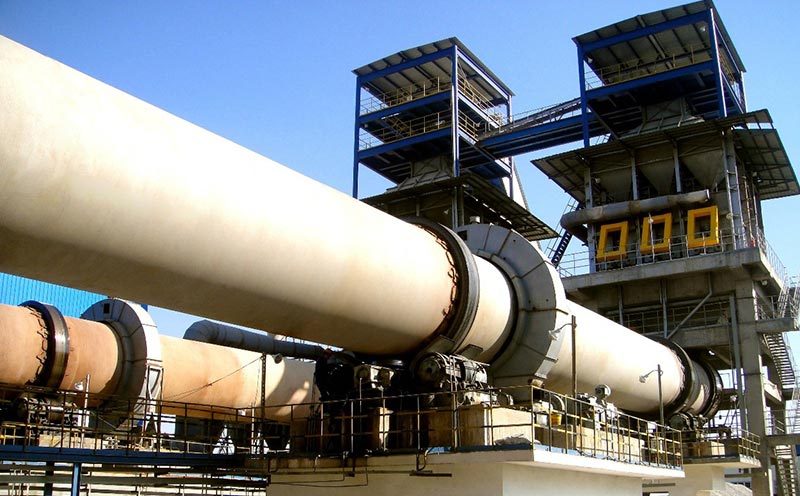

Time:

The main function of refractory materials for cement kilns is to serve as the lining of the cement kiln. It should maintain the high temperature required for firing cement clinker, while protecting the kiln equipment and reducing the heat loss of the kiln. In terms of refractory materials technology, refractory materials for cement kilns have developed from a few varieties such as clay bricks and high alumina bricks to a family of nearly a hundred materials. Today, refractory materials for cement kilns include sintered alkaline refractory materials, sintered aluminosilicate refractory materials, monolithic refractory materials and prefabricated parts, and insulated refractory products.
The development of cement production technology is mainly focused on the kiln process of cement clinker calcination. In the rotary kiln for cement production, the refractory lining configuration of each part is as follows:
The lining materials used in the discharge port and discharge belt of the kiln are subject to serious mechanical wear and chemical erosion, so the materials have higher requirements for abrasion resistance and resistance to sudden temperature changes. The discharge belt generally uses high alumina bricks with an Al2O3 content of 70-80%, thermal shock-resistant high alumina bricks, spinel bricks and magnesia chrome bricks; the discharge port uses heat-resistant concrete or silicon carbide bricks with corundum as aggregate. Corundum and alumina low-cement refractory castables and steel fiber-reinforced refractory castables are used for the front and rear kiln mouths. The kiln head cover uses 16B steel fiber high-aluminum refractory castables.
The temperature of the firing zone is relatively high, about 1200-1500°C. The firing zone generally uses magnesia-chrome bricks, direct bonded magnesia-chrome bricks, sodium polyphosphate bonded magnesia bricks, alkali-resistant bricks, spinel bricks, magnesia-zirconium bricks, and silica molybdenum bricks. These refractory materials usually have high strength in both cold and hot states, as well as good thermal shock stability, and have been increasingly widely used.
The transition zone is adjacent to the firing zone. The environment is characterized by high cylinder temperature and frequent temperature changes. The kiln skin hangs and falls off frequently, and chemical erosion is serious. Commonly used refractory materials in the transition zone include high alumina bricks made of corundum and bauxite (50-80% AI203), direct bonded magnesia chrome bricks, ordinary magnesia chrome bricks and spinel bricks. In recent years, silicon molybdenum bricks have been widely used in the transition zone of cement kilns.
The temperature of the cooling zone is still relatively high (about 1100-1300°C), but the chemical corrosion is not as serious as the front zone. Generally, high-alumina bricks, magnesia-chrome bricks, phosphate-bonded high-aluminum bricks, magnesia-alumina spinel bricks and corundum high strength low cement refractory castable.
In the part where the calcining zone is connected to the preheating zone, the thermal stress and chemical stress are small, so clay bricks, high alumina bricks, ordinary magnesia chrome bricks, etc. can be used. In the area connecting the calcining zone and the wave passing zone, the material has higher requirements for wear resistance and high temperature resistance. High alumina bricks with an Al2O3 content of 50-60%, ordinary magnesia chrome bricks, spinel bricks, special high alumina bricks and anti-flaking high alumina bricks, as well as calcium silicate boards and series of high-strength insulation bricks as thermal insulation materials, high aluminum low cement refractory castables, 50S anti-crushing castables can be used.
Preheating zone lining material needs to have sufficient alkali resistance and heat insulation properties, and its industrial applications are mainly based on alkali-resistant insulating clay bricks. If lightweight bricks are used, the temperature of the kiln barrel can be reduced by 60-100°C compared with clay bricks of the same thickness. For dry kilns, the unit heat consumption can be reduced by 21-38kJ/kg clinker.
The preheater system needs to use lining materials with good alkali resistance and heat insulation properties, such as a series of alkali-resistant bricks and alkali-resistant castables.
The refractory materials used in the cooler system include mullite high-strength wear-resistant castables, refractory bricks, lightweight castables, insulation bricks, insulation boards, etc. Ordinary magnesia chrome bricks and high alumina bricks can be used in the blanking throat area and high temperature areas; clay bricks can be used in medium and low temperature areas.
In addition to the above parts, other important equipment of the cement kiln needs to be lined with refractory materials.
Submit Request